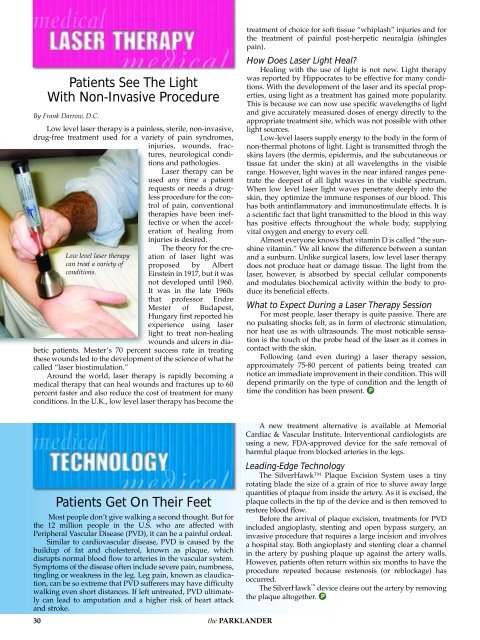Cover_Jan 05 (Page 2) - The Parklander Magazine
Cover_Jan 05 (Page 2) - The Parklander Magazine
Cover_Jan 05 (Page 2) - The Parklander Magazine
- No tags were found...
Create successful ePaper yourself
Turn your PDF publications into a flip-book with our unique Google optimized e-Paper software.
Patients See <strong>The</strong> Light<br />
With Non-Invasive Procedure<br />
By Frank Darrow, D.C.<br />
Low level laser therapy is a painless, sterile, non-invasive,<br />
drug-free treatment used for a variety of pain syndromes,<br />
injuries, wounds, fractures,<br />
neurological conditions<br />
and pathologies.<br />
Laser therapy can be<br />
used any time a patient<br />
requests or needs a drugless<br />
procedure for the control<br />
of pain, conventional<br />
therapies have been ineffective<br />
or when the acceleration<br />
of healing from<br />
injuries is desired.<br />
Low level laser therapy<br />
can treat a variety of<br />
conditions.<br />
<strong>The</strong> theory for the creation<br />
of laser light was<br />
proposed by Albert<br />
Einstein in 1917, but it was<br />
not developed until 1960.<br />
It was in the late 1960s<br />
that professor Endre<br />
Mester of Budapest,<br />
Hungary first reported his<br />
experience using laser<br />
light to treat non-healing<br />
wounds and ulcers in diabetic<br />
patients. Mester’s 70 percent success rate in treating<br />
these wounds led to the development of the science of what he<br />
called “laser biostimulation.”<br />
Around the world, laser therapy is rapidly becoming a<br />
medical therapy that can heal wounds and fractures up to 60<br />
percent faster and also reduce the cost of treatment for many<br />
conditions. In the U.K., low level laser therapy has become the<br />
treatment of choice for soft tissue “whiplash” injuries and for<br />
the treatment of painful post-herpetic neuralgia (shingles<br />
pain).<br />
How Does Laser Light Heal<br />
Healing with the use of light is not new. Light therapy<br />
was reported by Hippocrates to be effective for many conditions.<br />
With the development of the laser and its special properties,<br />
using light as a treatment has gained more popularity.<br />
This is because we can now use specific wavelengths of light<br />
and give accurately measured doses of energy directly to the<br />
appropriate treatment site, which was not possible with other<br />
light sources.<br />
Low-level lasers supply energy to the body in the form of<br />
non-thermal photons of light. Light is transmitted throgh the<br />
skins layers (the dermis, epidermis, and the subcutaneous or<br />
tissue fat under the skin) at all wavelengths in the visible<br />
range. However, light waves in the near infared ranges penetrate<br />
the deepest of all light waves in the visible spectrum.<br />
When low level laser light waves penetrate deeply into the<br />
skin, they optimize the immune responses of our blood. This<br />
has both antinflammatory and immunostimulate effects. It is<br />
a scientific fact that light transmitted to the blood in this way<br />
has positive effects throughout the whole body, supplying<br />
vital oxygen and energy to every cell.<br />
Almost everyone knows that vitamin D is called “the sunshine<br />
vitamin.” We all know the difference between a suntan<br />
and a sunburn. Unlike surgical lasers, low level laser therapy<br />
does not produce heat or damage tissue. <strong>The</strong> light from the<br />
laser, however, is absorbed by special cellular components<br />
and modulates biochemical activity within the body to produce<br />
its beneficial effects.<br />
What to Expect During a Laser <strong>The</strong>rapy Session<br />
For most people, laser therapy is quite passive. <strong>The</strong>re are<br />
no pulsating shocks felt, as in form of electronic stimulation,<br />
nor heat use as with ultrasounds. <strong>The</strong> most noticable sensation<br />
is the touch of the probe head of the laser as it comes in<br />
contact with the skin.<br />
Following (and even during) a laser therapy session,<br />
approximately 75-80 percent of patients being treated can<br />
notice an immediate improvement in their condition. This will<br />
depend primarily on the type of condition and the length of<br />
time the condition has been present. ● P<br />
30<br />
Patients Get On <strong>The</strong>ir Feet<br />
Most people don’t give walking a second thought. But for<br />
the 12 million people in the U.S. who are affected with<br />
Peripheral Vascular Disease (PVD), it can be a painful ordeal.<br />
Similar to cardiovascular disease, PVD is caused by the<br />
buildup of fat and cholesterol, known as plaque, which<br />
disrupts normal blood flow to arteries in the vascular system.<br />
Symptoms of the disease often include severe pain, numbness,<br />
tingling or weakness in the leg. Leg pain, known as claudication,<br />
can be so extreme that PVD sufferers may have difficulty<br />
walking even short distances. If left untreated, PVD ultimately<br />
can lead to amputation and a higher risk of heart attack<br />
and stroke.<br />
the PARKLANDER<br />
A new treatment alternative is available at Memorial<br />
Cardiac & Vascular Institute. Interventional cardiologists are<br />
using a new, FDA-approved device for the safe removal of<br />
harmful plaque from blocked arteries in the legs.<br />
Leading-Edge Technology<br />
<strong>The</strong> SilverHawk Plaque Excision System uses a tiny<br />
rotating blade the size of a grain of rice to shave away large<br />
quantities of plaque from inside the artery. As it is excised, the<br />
plaque collects in the tip of the device and is then removed to<br />
restore blood flow.<br />
Before the arrival of plaque excision, treatments for PVD<br />
included angioplasty, stenting and open bypass surgery, an<br />
invasive procedure that requires a large incision and involves<br />
a hospital stay. Both angioplasty and stenting clear a channel<br />
in the artery by pushing plaque up against the artery walls.<br />
However, patients often return within six months to have the<br />
procedure repeated because restenosis (or reblockage) has<br />
occurred.<br />
<strong>The</strong> SilverHawk device cleans out the artery by removing<br />
the plaque altogether. ● P
















